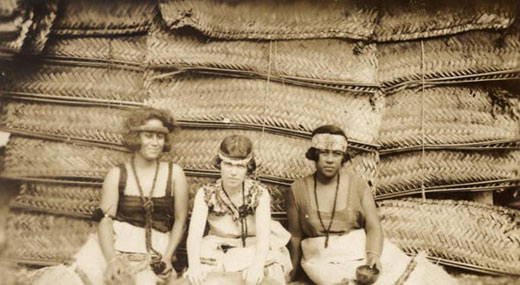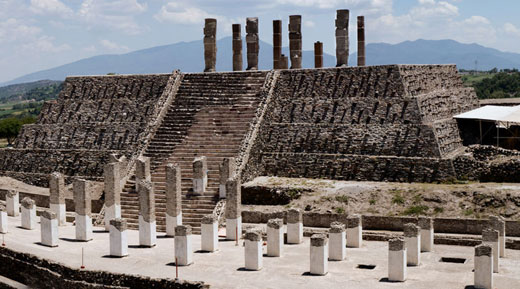By Megan Tusler: With the publication of Coming of Age in Samoa, Margaret Mead brought to her audience in 1928 a readable vision of adolescent sexuality derived from nine months of fieldwork on the island of Ta’u.

The work begins, “The life of the day begins at dawn, or if the moon has shown until daylight, the shouts of the young men may be heard before dawn from the hillside. Uneasy in the night, populous with ghosts, they shout lustily to one another as they hasten with their work.” Mead opens her work with a twist: she describes the men of Ta’u hastening to their work, but what she’s really describing is a Morning After scenario, a Walk of No Shame, because these men are returning from al fresco sexual adventures of the night before: “As the dawn begins to fall among the soft brown roofs and the slender palm trees stand out against a colorless, gleaming sea, lovers slip home from trysts beneath the palm trees or in the shadow of beached canoes.” Her titillating glance into the evening habits of her Indigenous subjects provides the material for her first ethnography, written for a general reader, that detailed the sexual habits of adolescent girls in Samoa. She hoped, in this work, to demonstrate that the rigid sexual strictures of American society weren’t “natural” or right — and that they could be overcome to the betterment of society more generally.
It almost certainly goes without saying that Mead’s work has been plagued with criticism since its publication. One spectacular example is the so-called Mead-Freeman controversy, in which anthropologist Derek Freeman refuted Mead’s findings by retrying them in the court of the culture wars, arguing that she had been “hoaxed” by her Samoan informants who had been only too happy to play up the life imagined by their visitor. These claims have been put to rest, at least to some degree, by works like Paul Shankman’s The Trashing of Margaret Mead (2009), which argued that the attack on Mead’s work was highly personal and itself indebted to settling an ideological score, as Freeman insisted on a sociobiological approach to anthropology to the exclusion of considerations of social environment. There’s also a frothy right-wing dismissal of the “social construction” argument that has found its way to Mead’s work, as some researchers in fields like evolutionary psychology contest the very idea that developmental stages like adolescence are affected by environment at all; this, despite the many comparative studies that have demonstrated the diverse range of adolescent experience across both time and space.
Deborah Beatriz Blum’s new biography, Coming of Age: The Sexual Awakening of Margaret Mead, is primarily concerned with providing a narrative for understanding how Mead’s interests, friendships, and intellectual training led to Coming of Age in Samoa. In Blum’s account, Mead’s early 20s as a pioneer, provocateuse, and sexually liberated intellectual powerhouse shaped the famous anthropologist in ways that would exert tremendous influence on the social sciences as the century lurched forward. Coming of Age focuses primarily on the period of Mead’s educational life in the social and cultural ferment of the 1920s, leading up to her fieldwork in Samoa. The characterization of Mead and her cohort relies almost exclusively on Blum’s archival mining: she reads Mead’s letters, as well as those by fellow anthropologist (and Mead’s lover) Ruth Benedict, anthropologist-linguist (and Mead’s lover) Edward Sapir, and archaeologist (and Mead’s first husband) Luther Cressman in order to outline the social circle that influenced Mead’s methods and findings in Samoa.
Blum’s book is an exercise in historical dramatization. The primary characters circulate through romantic entanglements that arise from the plot of Mead’s early career, the letters among the four leads serving as gossipy documents animating their lives. The method makes for accessible reading — with the letters reimagined into novelistic scenes, the book keeps a brisk pace. But it also makes it difficult for the author to critically evaluate Mead and her colleagues, primarily because the book unfurls its narrative almost exclusively from within the minds of its subjects. Mead’s interiority dominates here, even with the inclusion of the three other voices, and the view from within her mind induces a troubling biographical tunnel vision.
This marks an unfortunate aspect of Blum’s biography because, while the less-convincing criticisms of Mead limned above have perhaps unfairly pilloried her work, there are legitimate critiques that her biographer might have taken up. Among these are questions about whether “objectivity” is even possible in ethnographic methods. Despite her avowed interest in plumbing Mead’s archive, Blum refrains from thinking reflexively about methodology, hers or Mead’s. By doing so, she neglects to engage with the important shifts in ethnographic methods since the 1990s that have allowed the social sciences to denaturalize the relationship between Objective Researcher and Primitive Subject in qualitative research, a change that necessarily reflects critically on Mead’s approaches. Blum’s methodology also shows its weaknesses in its nonreflexive stance; by taking letters as the gold standard for an individual’s historical significance, Blum risks positioning the subject as an objective expert on herself.
Further, Blum’s treatment of both Mead and her friend and lover Ruth Benedict remind the reader of the extent to which feminism’s first wave is characterized by a political ideology that elevates liberal, individuated personal sovereignty above a common good (as opposed to the collectivist vision of the early socialist feminisms articulated by Emma Goldman and other leftists). As Louise Michele Newman argues in White Women’s Rights (1999), Mead’s work “helped foster a liberal feminist critique of U.S. society, which attacked patriarchy for placing restrictions on women’s expression of sexuality and conceptualized a ‘free’ society as one that permitted women ‘choice’ in how they lived their sexual lives.” In other words, Mead’s achievement might be reframed as allowing white women, to the exclusion of their “primitive” counterparts, to imagine and access a sexually liberated future. Blum takes Mead’s sexual exploits — which do seem like a lot of fun, but also don’t liberate anyone except Mead herself from Protestant social strictures — as a gesture of prescient radicalism toward a sexual revolution instead of what they are: a 23-year-old woman banging all her friends.
A methodological critique of Mead (and of early Western-liberal feminism more generally) centers on the degree to which the ethnographic researcher can consider herself “objective” in any sense. It also rethinks how research on the “primitive” Global South might take Indigenous practices and ways of knowing out of context, and describes how these methods may underappreciate the degree to any given society is hybridized. Mead is explicit that this work is qualitative, based on interviews, and particular to Samoa. But in Blum’s book, early anthropologists’ obsession with “owning” groups of people is never given critical reflection, and this is, at least in part, a problem of both Blum’s method — her overreliance on letters as historically and personally factual — and the genre of biography in which she operates. Describing Mead’s first talk at the British Association for the Advancement of Science in 1924, Blum recounts the young researcher’s reaction to the luminaries in the room:
She was eager to see, with her own eyes, the men who were considered the most renowned anthropologists in the world: A. C. Haddon, an expert on the cultures of Melanesia and the author of Head-hunters: Black, White and Brown; and Charles Seligman, the Africa scholar, who used his knowledge of physiology to identify the Bushmen, Pygmies, Negroids, and Hamites, the four distinct races that inhabited the African continent.
[…]
More and more, it was sinking in that each one of these anthropologists had a “people.” Margaret, too, wanted to have a people on whom she could base her own intellectual life.
The form that Blum’s book takes in such moments demonstrates the potential failure of a incautious archival analysis, and of a biographer who too easily accepts Mead’s version of herself, perhaps the hazard of embedding oneself in the correspondence of such a charismatic historical figure. Drawn from Races of Africa(1930), Seligman’s racial phyla described above are hierarchical and emphasize the “Hamitic hypothesis,” which asserts that the major African civilizations are founded by the “Hamites” instead of arising from “Negroid” peoples. The substitution here is marked by an imperialist agenda that appears more coded to us today; early 20th-century readers would have understood “Hamite” to mean “more white” than other African groups. Such racial categories and hierarchies were crucially important to early anthropology as both methodology and object of inquiry, and Mead was very much indebted to a tradition that invented new genres of racialization. Writing uncritically in Mead’s voice, Blum doesn’t reflect on the appalling effects of separating, for example, the “African races” or of simultaneously rewriting history to discount the contributions to civilization of groups considered “black” by early 20th-century readers.
That omission has significance for the feminist politics of Mead’s work, as well as Blum’s biography because these genres of racialization, which have demanded continual renewal at a structural and sociopolitical level across the centuries, emerge in the peculiar sentimentalism of early 20th-century feminist works that sometimes advance the larger imperialist cause. As Laura Wexler recounts in Tender Violence (2000), the work of women photographers, journalists, and anthropologists helped to erase “the violence of colonial encounters in the very act of portraying them.” These portrayals sentimentalized and romanticized their subjects in order to erase the violence of the imperial project. The dominance of this approach can be seen in Mead’s romanticization of her subjects and in her belief that their example might liberate constructions of sexuality for white feminists.
It is important to note that this sentimentalism and the degree to which it was determined by the ethnographic genre in which she chose to work has historical specificity. For this reason, it’s difficult to read Mead as a singular historical figure or even as the trailblazer that Blum fashions for the reader. That Mead believed she could evaluate human subjects without causing any effects at all is a startling claim now rightly seen to be breathtakingly naïve. The practice of field research that Mead undertook in Samoa contributed to a discipline responsible for recordings of Indigenous languages that have been crucial to the language revitalization efforts happening now. The wax cylinder recordings made by anthropologists and housed at the National Museum of the American Indian contribute to the ongoing renewal of languages like Menominee and Omaha. But the anthropological field has had to reflect on its origins, particularly after a series of controversies over whether its methods had negatively impacted “primitive” groups that it studied.
If Mead thought that she could perform research without impacting the groups that she studied, Blum’s reading of Mead’s letters indicates that she also thought she could make her way through any social environment without negatively impacting it. At such moments, Blum’s reading makes Mead seem remarkably callous, insensitive to her friend and lover Ruth Benedict as well as to her first husband Luther Cressman. Blum unknowingly illustrates this midway through the book, when she recreates a scene between Edward Sapir and Benedict. Sapir is the first speaker.
“Margaret and I are lovers,” he said. “No doubt she will tell you. She tells you everything.” […]
When Ruth still didn’t say anything, Edward said, “I don’t understand, though. Just what is her relationship with Luther [Cressman]?”
“Luther?” Ruth paused. “She loves Luther.”
“With you I can be utterly frank,” Edward said. “I do not believe in the love of Luther and Margaret, nor do I think that most observers who know them sincerely believe in it.”
But “Margaret” does believe in it, and strings Sapir along until his attentions become too intense for her. In Blum’s archival imagination, Benedict is devastated by Sapir’s revelation:
Edward’s talk of making love to Margaret was unbearable […] Not that long ago she — Ruth — had loved Edward, wanted him for herself. Margaret knew that. But that’s not what hurt. What hurt was that Edward had experienced the erotic side of Margaret that she, Ruth, had only fantasized about, and lately, at night, those fantasies had come unbidden.
In the logic of the biography, these are Mead’s lovers’ responses to an adventurous woman, a sexual revolutionary. It’s no wonder that the book’s subtitle is “The Sexual Awakening of Margaret Mead,” although this could use the addendum, “at the expense of nearly everyone she knew,” or “through interpreting Indigenous sexual practices as she liked.” Mead so clearly found herself to be living the most adventurous life that she might imagine.
This attachment to Mead as a “radical” subject is a part of the cult of personality she developed around herself. She also strongly advocated a notion of individualist liberal politics that allowed her to be insignificant, and even powerless, when she wanted to be. Speaking at a special event with James Baldwin in 1970 (the conversation is transcribed in A Rap on Race) the two argue over the individual’s “responsibility” in the context of social events:
MEAD: Did you bomb those little girls in Birmingham?
BALDWIN: I’m responsible for it. I didn’t stop it.
MEAD: Why are you responsible? Didn’t you try to stop it? Hadn’t you been working?
BALDWIN: It doesn’t make any difference what one’s tried.
MEAD: Of course it makes a difference what one’s tried.
BALDWIN: No, not really.
MEAD: This is the fundamental difference. You are talking like a member of the Russian Orthodox Church … “We are all guilty. Because some man suffers, we are all murderers.”
BALDWIN: No, no, no. We are all responsible.
MEAD: Look, you are not responsible.
Mead prioritizes making the individual insignificant in a scene like the South Seas, where she seeks to “minimize” her own presence. Disputing Baldwin, she lauds the sentiment of individual exception whereby a person can be innocent of the actions of her society. An individual agent can be exceptional for Mead, but she can also be deliberately invisible, as small or as significant as she chooses.
Coming of Age: the Sexual Awakening of Margaret Mead thus leaves us with a number of problems about the status of the individual historical figure, the contested history of anthropology, and the genre of biography. On one hand, in keeping with the tendencies of its form, the biographical representation of Margaret Mead relies, necessarily, on the singularity and virtuosity of its subject. Blum underserves Mead in producing a subject that feels individuated, special, uniquely courageous, and genius. Mead’s behavior, research, and work all have a historical context — Blum, for example, makes much of Mead’s retaining her family name upon her marriage to Luther Cressman in 1923. But the Lucy Stone League, which advocated women keeping their last names at marriage, had been founded in New York in 1921 and, while women rarely used their family name after marriage in the 20s, there was a cultural precedent for it. A number of other famous women — Anita Loos, Isadora Duncan, Edna St. Vincent Millay — had done it as well. Mead, again, isn’t a singular figure, she’s a historical one — but Coming of Age wants only historical sprinklings devoid of the richness of full historical context. The individual emerges as the primary object of a historical inquiry rather than as an actor on a much larger stage, a tendency only exacerbated by studying someone who prioritized the individual as the primary unit of liberation.









































